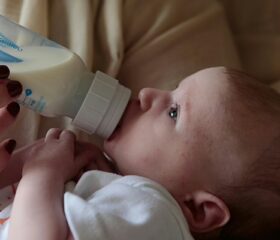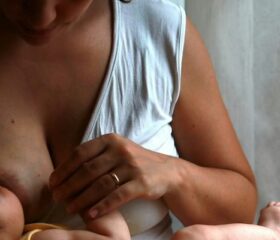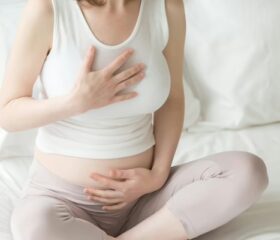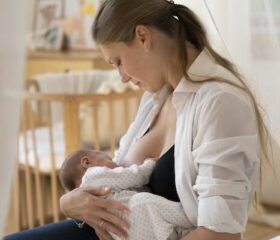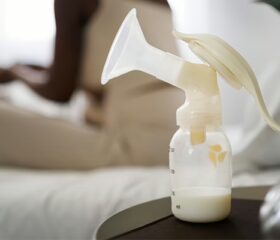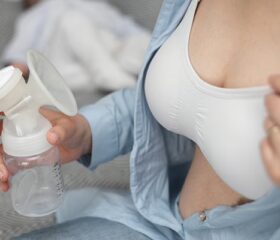What Are Milk Blebs and How Do You Treat Them?
Breastfeeding is a wonderful way to connect with your baby, but it’s not without its challenges. One of the most common issues breastfeeding moms face is the appearance of blisters.
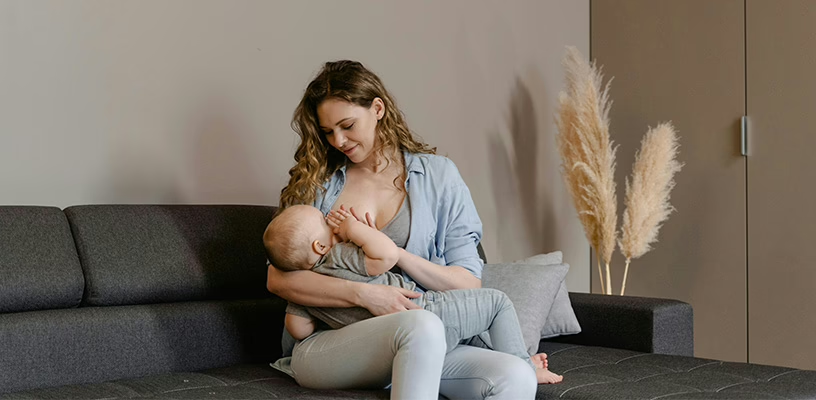
Often known as “milk blebs,” these small, white, or yellow spots are uncomfortable and can sometimes even block your milk flow. Let’s walk through what they are in more detail and what you can do if you get them.
What is a milk bleb?
A milk bleb is a blocked nipple pore. When you breastfeed, sometimes a milk duct will get clogged, causing milk to back up and form a small, raised spot on your nipple’s surface. 1
Again, blebs often look like tiny white or yellow pimples or blisters. They may appear in single spots or clusters. Sometimes, a thin layer of skin will grow over the bleb, which further prevents your milk from flowing and slows down the healing process.
Don’t confuse a milk bleb for another issue, like a clogged Montgomery gland (the oil-producing glands on your areolas that become more prominent during pregnancy). Although these can be uncomfortable, like milk blebs, they show up on a different part of the breast and aren’t directly caused by breastfeeding.
What do milk blisters feel like?
Milk blebs vary in how they feel from mom to mom. For some women, they’re painless. However, they can also be uncomfortable, especially when your baby latches on to feed.
You might also notice inflammation around the bleb and feel engorged or full, especially in parts of the breast where the milk ducts are entirely blocked.
What causes blebs?
Here are some of the potential root causes of backed-up nipple pores, which can turn into milk blisters: 2
- Improper latching: If your baby isn’t latching correctly or otherwise isn’t feeding correctly (e.g., he’s a sleepy feeder or has a tongue tie), he may not be fully emptying your breasts. This can lead to milk buildup and clogged ducts.
- Pressure on your nipples: Tight-fitting bras, underwire bras, or any other excessively tight clothes can put pressure on your nipples, irritating them and potentially clogging them.
- You have too much milk: Producing more milk than your baby can effectively eat can also cause backups and clogged ducts. 3
Treating blebs at home
The good news is that you can often treat milk blisters at home. You can try:
- Warm compresses: Cover your affected nipple with a warm, wet washcloth for 1 to 2 minutes before breastfeeding. 4 This helps soften the area and encourages the duct to open.
- Saline soak: Try soaking your nipple in a saline solution at least four times daily. Use half of a teaspoon of salt and 1 cup of warm water. 5
- A gentle massage: Gently massaging the area around the bleb, moving towards the nipple, may help dislodge any trapped milk. Don’t be too aggressive, though, as this can make the blebs more inflamed. 4
- Moisturizing: Apply a natural oil, such as coconut or olive oil, to keep the skin around your nipples soft. 5
Relatedly, do not pop your milk blebs! While popping milk blisters may give you some short-term relief, you increase the risk of infection or inflammation, and you may even scar your nipple and milk ducts.
How to prevent milk blisters from forming
It’s often easier to prevent milk blebs from forming in the first place than to treat them when they do appear. Here’s how you can stop these unwelcome bumps from showing up:
- Experiment with different nursing positions: Make sure that all the parts of your breast are being emptied. This also helps avoid putting constant pressure on the same spot on your nipple.
- Keep breastfeeding: Regularly nursing or pumping prevents milk from stagnating in your ducts. Keep track of your sessions in a journal or baby tracker app, and if your baby skips a feeding, make sure you pump or hand-express your milk to prevent your breasts from engorging. 1
- Get comfortable: Wear bras and clothing that aren’t too tight and don’t put pressure on your nipples. Especially if you’re just starting breastfeeding, stay away from underwire bras completely.
- Keep your nipples clean: After nursing, gently wipe your nipples with a clean, damp cloth to help prevent clogged pores.
- Stay hydrated: Drinking lots of water benefits your milk production and cuts the risk of blocked ducts by keeping your skin soft and supple. 6
- Speak to an expert: If you’re overproducing milk, speak with a lactation consultant or your doctor about how to manage that. They may recommend block feeding or other techniques to regulate your milk supply. 7
On the note of regular nursing and pumping sessions, don’t worry about the excess milk going to waste. You can store your breast milk in the freezer for up to 12 months, which means you’ll have a ready supply for future feedings.
Good latching
Making sure your baby latches properly is one of the best ways to prevent blebs. You can tell your little bundle of joy has a good latch if:
- His feeding feels comfortable and is pain-free.
- Your baby’s chest and stomach are against your body—his head should be straight, not turned sideways. His chin should also be touching your breast.
- You see or hear your baby swallowing and his lips are turning out.
- Your little one’s mouth is wide around your breast and not just on your nipple.
According to experts, it’s best to maintain skin-to-skin contact with your baby when feeding to make sure he latches properly. Let your baby find your nipple on his own; use your hands to support his neck, shoulders, and hips. 8
Blebs, blisters, thrush, and mastitis: what’s the difference?
Milk blebs (blisters) are different from “normal” blisters, thrush, and mastitis. Here’s how you can spot the difference:
Other blisters
Compared to milk blebs, nipple blisters are usually larger and less painful or uncomfortable. They’re caused by irritation or injury, often from a breast pump or shield. Nipple blisters usually go away quickly once you identify what’s causing the irritation and stop it. 9
Thrush
Thrush is a highly contagious fungal infection. If you have thrush, you’ll feel widespread pain, and your breasts will have multiple white patches along with shiny, red, or pink nipples. Other symptoms include flaky, itchy, or blistered skin.
See your doctor straight away if you have thrush, as it can easily pass back and forth between you and your baby. Your baby will have white spots on his gums, tongue, and inside his mouth if he’s also infected. 1 Your doctor will likely prescribe antifungals to treat thrush.
Mastitis
Blebs can also lead to mastitis, or inflammation of the breast. Your breasts can get infected if bacteria enter through a crack in the skin on your nipple or through a duct opening. The bacteria will then spread through your breast milk. 10
Look out for signs such as: 1
- Swelling and pain in your breasts
- Redness and warmth around the infected area
- Flu-like symptoms
- Yellow discharge
If you notice signs of mastitis, speak with your doctor immediately. You may need antibiotics to treat it.
When to see a doctor about your milk blebs
Many cases of milk blebs will resolve with home care. Aside from cases of thrush and mastitis, see a doctor if:
- Your milk blister doesn’t improve after several days of home treatment
- Your pain is severe or worsening
- You have recurring milk blebs
Your OB/GYN can offer further treatment options for blebs. These may include prescribing a steroid ointment to reduce inflammation and draining the bleb with a sterile needle.
Get your doctor’s OK first if you want to use over-the-counter pain medication such as acetaminophen (Tylenol) or ibuprofen (Advil). 11
Final thoughts
Dealing with milk blebs is an uncomfortable part of many moms’ breastfeeding experiences. Be patient—while they can be painful, milk blebs usually aren’t anything to worry too much about.
Do your best to take care of them at home and keep your doctor up-to-date. Milk blebs often fade quite quickly, so rest assured you can get back to enjoying breastfeeding your baby soon. Don’t let that urge to pop them get the better of you!
Article Sources
- The Children's Hospital of Philadelphia. "Plugged Milk Ducts" Retrieved July 11, 2025.
- Medical News Today. "What causes milk blebs?" Retrieved July 11, 2025.
- Cleveland Clinic. "Hyperlactation Syndrome" Retrieved July 11, 2025.
- WIC Breastfeeding Support. "Help for Sore Nipples" Retrieved July 11, 2025.
- California Breastfeeding Coalition. "Common Breastfeeding Challenges" Retrieved July 11, 2025.
- Medical News Today. "Is it possible to prevent milk blebs?" Retrieved July 11, 2025.
- La Leche League International. "Oversupply" Retrieved July 11, 2025.
- WIC Breastfeeding Support. "Steps and Signs of a Good Latch" Retrieved July 11, 2025.
- Medical News Today. "Milk bleb vs. blister" Retrieved July 11, 2025.
- MedlinePlus. "Mastitis" Retrieved July 11, 2025.
- Medical News Today. "What are the best treatments and remedies for milk blebs?" Retrieved July 11, 2025.

